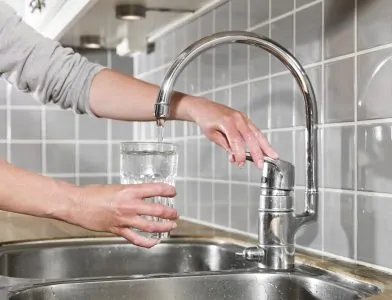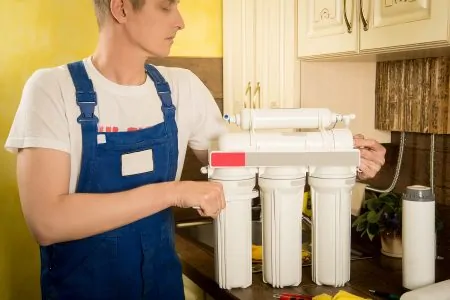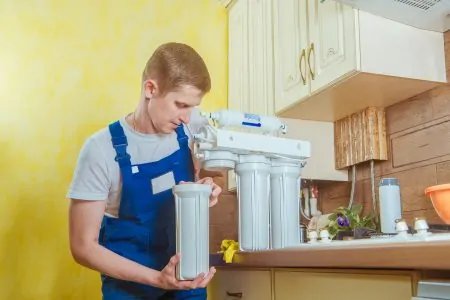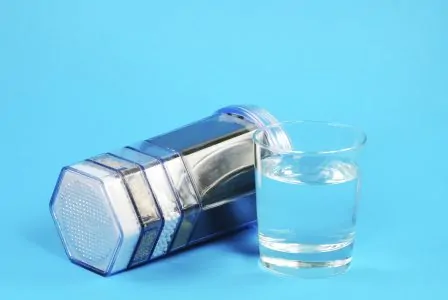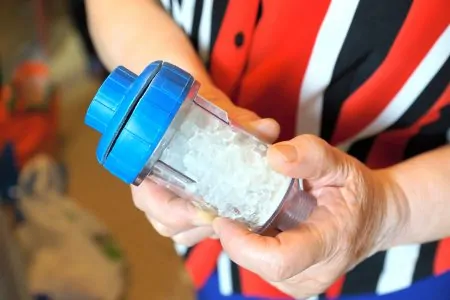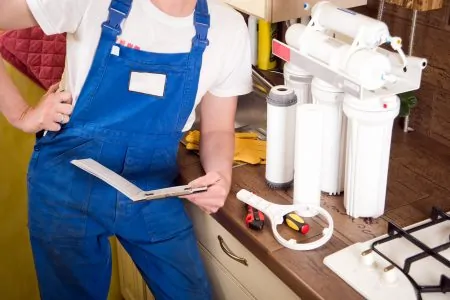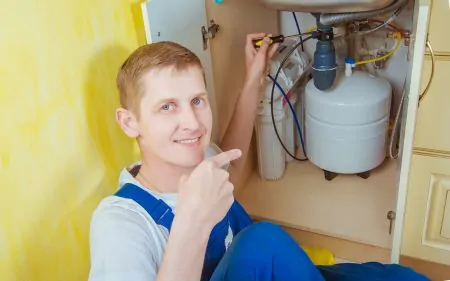If you have ever visited a public swimming pool, you are probably familiar with the smell of chlorine. Chlorine is a highly effective cleaner and disinfectant, but did you know that it is also in your drinking water?
Chlorine may be a powerful water purifier, but it remains a controversial chemical. If you’re wondering whether or not you should ingest something that burns, smells, and dries your skin, you’re not alone.
In this article, we will explain how to remove chlorine from your water so it can be healthier while remaining pure. Before that, we will explain everything you need to know about chlorine so you can decide if removing it is the right choice for you.
Key Takeaways
- Chlorine is a popular disinfectant but can have negative health effects.
- Removing chlorine from water can be done using methods like filtration, evaporation, and boiling.
- Chloramine, a combination of chlorine and ammonia, is harder to remove from water.
- Investing in a water filter or other purification methods can improve water quality and protect your health.
What Is Chlorine?
Chlorine is most commonly used to keep swimming pools looking clean, but there’s more to it than meets the eye. Industrially, chlorine serves more purposes than we can count.
It is used as a pesticide and food preserver and is a component in manufacturing everything from plane seats to bulletproof vests. It also plays a role in energy, construction, computers, and healthcare (1). You might be wondering how it is possible that a cleaning agent we swim in is so versatile.
Did you know that chlorine isn’t man-made and that it is not a liquid? In fact, it is a chemical element — number 17 on the periodic table — that occurs naturally as green gas. Using the power of science, it is possible to alter its form and utilize it more effectively.
Is Chlorine Safe to Drink?
Pool owners often take chlorine use for granted, but it still has a bad reputation. It has been blamed for skin irritation and is wrongly pointed to as the reason that your eyes burn when you swim.
In reality, chlorine isn’t to blame. Scientists have discovered that chlorine alone doesn’t harm your eyes. It only burns them when it reacts to urine in your pool (2).
As disgusting as that sounds, it is the exact reason why chlorine is added to drinking water. Water is easily contaminated and chlorine has excellent disinfectant properties. It binds to and destroys bacteria and other germs far more effectively than most alternatives.
Still, chlorine is a highly toxic chemical that can be very dangerous if it is not handled properly (3).
The Dangers of Chlorine
Chlorine deserves recognition for reducing the risk of diseases spreading, but that’s largely where its benefits end. Pathogens are removed from your water, but there could be other repercussions for your health. Here are some negative potential side effects that you should keep in mind:
- Your gut may suffer: Bacteria is no match for chlorine, and that’s part of the problem — chlorine can also destroy the good bacteria in your intestines. This might also make chlorine a carcinogen, as one study concluded that it increases the risk of colonic tumor growth (4).
- Birth defects are possible: A Taiwanese investigation linked chlorinated water to a rise in birth defects. The study claims that, if ingested during pregnancy, chlorine could cause cleft palates, as well as heart or brain issues (5).
- Food allergies: A study published in the Annals of Allergy, Asthma, and Immunology found that chlorine byproducts may be the reason we react badly to some foods. Further research is needed but it is possible that chlorine is responsible for the increased rate of food allergies (6).
- It’s a toxin: Chlorine is so toxic that it has been used in warfare. It was weaponized in World War One, the Iraq War, and even today in Syria (7). When inhaled, chlorine becomes deadly hydrochloric acid.
Chloramine: A Bigger Problem
There is good news and bad news. On one hand, chlorine is losing favor in water purification due to its harmful effects. On the other, it is largely being replaced by its byproduct: chloramine.
Chloramine is a combination of chlorine and ammonia. It serves the same function and has similar attributes, though it is less potent. The downside is that chloramine is far more difficult to remove from water.
Quick Tip
How to Remove Chlorine from Water
Removing chlorine from your water is relatively easy, and the health benefits will outweigh whatever you pay for parts or labor. It’s time to find out how to get the chlorine out of your water.
Water Filtration
Most water filtration systems use a process called reverse osmosis. Reverse osmosis will remove chlorine and other impurities from your drinking water.
Water flows through a special membrane that won’t allow contaminants to pass, meaning they get left behind.
Reverse osmosis systems are used industrially, but they are also available for home use. They are highly regarded for their effectiveness in purifying water of almost all pollutants.
Pros
- Highly effective
- Automated operation
- Available for home use
- Softens water
Cons
- Installation required
- Not all filters will remove chloramine
- Can be expensive
Evaporation
Chlorine is a volatile chemical, which means it evaporates easily. If you’re looking for a way to remove chlorine from your water without spending any money, simply leave it to stand. The chlorine will gradually remove itself from the water via evaporation.
Leaving water out can remove chlorine from your water, but it isn’t without its drawbacks. You will need to exercise patience, as it isn’t an instant solution to your chlorine problem.
Your location will influence how quickly the chlorine evaporates. Chlorine is a gas at room temperature, so the warmer the air, the faster it will disperse. You can also leave your water in an open jug in your refrigerator, but it will take longer (at least 24 hours) to clear.
Pros
- Effortless
- Costs nothing
- Natural solution
- No tools or installation are necessary
Cons
- Not an instant solution
- Ineffective against chloramine
Chemical Purification
It may seem counterproductive to add more chemicals to your water, but chemical treatment is a legitimate way to combat chlorine. There is some chemistry involved, so this method may not be for everyone.
Potassium metabisulfite (K-meta) is the most effective treatment for chlorine. As one of these tablets is dissolved into water, it neutralizes chlorine, and then — being volatile itself — it evaporates away.
It works against chlorine and chloramine and is commonly used in breweries and wineries. It is also powerful — one potassium metabisulfite tablet can dechlorinate up to 20 gallons of water.
Pros
- Inexpensive
- Also works against chloramine
- Relatively effortless
- Works quickly
Cons
- Can be difficult to find
- Produces a pungent smell
UV Light
This is a highly effective method of water purification, though it is less popular than water filtration.
If you can get your hands on an ultraviolet light, you can use it to dechlorinate your water. It is effective against chlorine and chloramine and doesn’t have the drawbacks of chemical treatment or filtration.
Chlorine is a light-sensitive chemical, so UV rays break down and destroy traces of it. The longer chlorine is exposed to UV light, the further it dissipates.
The main problem is that UV lights aren’t exactly available from your local DIY store. They can cost a lot of money to acquire, and prolonged exposure is harmful to your skin.
Pros
- No chemicals required
- Clears both chlorine and chloramine
- Doesn’t affect the taste
Cons
- Not budget-friendly
- Exposure to dangerous UV radiation
Boil Your Water
If you would prefer to remove the chlorine from your water naturally, you could use the most basic method of purification: boiling it.
The science is simple: as chlorine is volatile, the warmer it is, the faster it evaporates.
It is recommended that you boil your water for at least 20 minutes to be safe. There aren’t many drawbacks to this method; it is effective and requires minimal effort.
However, you will need to monitor your water, and it uses extra energy. There are no added chemicals, and you won’t have to spend money on equipment or installation, so this is a small price to pay.
Pros
- Minimal effort
- No additives or equipment needed
- Removes the chlorine taste from water
Cons
- Higher energy bills
- Won’t remove chloramine
FAQs
Conclusion
Chlorine has a variety of uses and is an important component in many modern industries. However, adding it to drinking water has long been a source of controversy and can have a negative impact on your health. It is a highly effective disinfectant, but it is also toxic and the risks aren’t necessarily worth its benefits.
Whether or not you should look to remove the chlorine from your water will largely depend on the quality of your local water supply. It might also depend on the sensitivity of your skin, as chlorine can irritate people with delicate skin.
